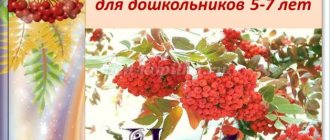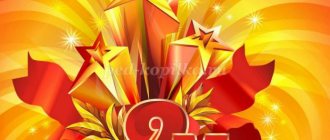Topic: “My Country”
Integration of educational areas: “Cognitive development”, “Socio-communicative development”, “Physical development”.
Software tasks:
Educational field “Speech development”:
- Enrich and activate children's vocabulary on the lexical topic “My Country”.
- Develop the ability to form and use in speech nouns in the plural form R.p.
Educational area "Cognitive development":
- To form children's ideas about their native country.
- They will continue to introduce children to public holidays (National Unity Day).
- Introduce children to the flag of the Russian Federation.
Educational field “Social and communicative development”:
- To evoke in children a sense of admiration for the talent of the Russian people and pride in their people. To cultivate love for the Motherland, a sense of pride in one’s country.
Educational field "Physical development":
- Develop gross motor skills and fine motor skills of the hands.
Equipment:
- pictures with the image of the flag of the Russian Federation, the capital - Moscow, a globe, pictures for the game “There is a lot of things in Russia” (rivers, seas, mountains, forests, cities, people, animals, etc.)
My country. Lesson in a preparatory group
Lesson in the preparatory group “My Country”.
Goal:
To deepen and clarify ideas about the homeland.
objectives :
continue to consolidate children’s knowledge about Russia, about its capital, Moscow;
introduce Russian symbols. Educational:
to cultivate love for the Motherland and respect for people of different nationalities.
Developmental:
develop thinking, memory.
Equipment:
subject pictures depicting Russian symbols, an audio recording of the Russian anthem, pictures depicting several views of Moscow (Red Square, Bolshoi Theater, Cathedral of Christ the Savior, etc.), colored strips of paper in red, blue and white, an image of the Russian flag and other countries (2-4 countries)
Lesson progress:
- Guys, what is the name of our country?
(Russia) - What are the people of Russia called? (Russians). - Let's look at our globe to see what a large, vast area Russia occupies. — What can we tell about our country? Invite children to name the symbols of the Russian state (flag, coat of arms) that are presented in the subject pictures. Invite the children to stand up and play the recording of the Russian anthem. The anthem is also a symbol of the Russian state. We talk about our country based on subject pictures. The country we live in is called Russia. Russia is a state. It has its own symbols, you have already named them. You should be proud of the symbols of the country. The Russian anthem is always played at ceremonial events when awards are given to Russians for their achievements. Whenever the anthem is played, you must stand and listen to it while standing. Our country is led by a president (show a photo of the president and memorize his last name, first name, patronymic). There are many cities, forests, rivers and lakes in our country. Forests, rivers, lakes are the wealth of our country. Russia is the biggest country in the world. Russia is our Motherland. — Guys, I wanted to show our flag, but the problem is, I mixed up all the flags, help me choose the Russian flag. - Right. How did you find him? (Russia has a tricolor flag, three stripes - white, blue, red.) -What do they mean? (White is the color of peace, it says that our country is peace-loving. Blue is faith. Red is the color of strength, it symbolizes the blood shed for our Motherland). — Now, let's look at the coat of arms of Russia. What can you tell about him (the coat of arms depicts an eagle, which denotes the strength of the state, an eagle with two heads and raised wings; he has a crown on his head, in one paw he holds a ball - this is a power, and in the other - a rod - this is a scepter ) . - Why does the eagle have two heads (the Russian state is large, and the heads look west and east, showing that it is one). Physical education minute.
Every country has a main city. The main city of the country is called the capital. — Which city is the capital of Russia? (Moscow) Show children pictures depicting several views of Moscow (Red Square, Bolshoi Theater, etc.) and talk about its main attractions, practice subject vocabulary: the Kremlin, chimes, temple, Bolshoi Theater, Red Square. Russia is a state in which people of different nationalities live. It is called a multinational state. People of different nationalities live together, some nationalities have their own republics, for example Tatarstan, Chechnya, Dagestan, Karachay-Cherkessia, Kalmykia, etc. The majority of the population of Russia is Russian. All peoples of Russia have one state language – Russian. People of different nationalities should live together and respect each other. Every person loves his country, protects it from enemies, and protects its wealth. When you grow up, you will also defend your homeland. People call their homeland not only their country, but also their home, kindergarten, school, city, region. At the end of the conversation, read Zykova’s passage “Motherland” to the children. A dear home, familiar from childhood, Where granny puts the dough; The school where my brother studied; My favorite kindergarten; All my friends, girlfriends, Sleds, balls, toys, Mom, dad, brother and me - This is my Motherland!

